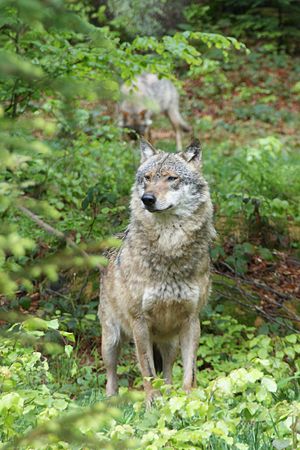Field Guide/Mammals/Gray Wolf
< Field Guide | Mammals
| Canis lupus (Gray Wolf) | |
|---|---|
|
Family: Canidae
Size: 4.5-6.0 ft (1.37-1.83m) in length, 40-175 lbs (18.14-79.38 kg) in weight
Description: The Gray Wolf is a large, densely furred dog with a bushy tail.[1] It is the largest of the Canidae family. Its long fur varies in color from pure white through gray and brown to black, and it generally resembles the German shepherd or husky.[2] It has long legs and small ears, and has a long muzzle.[3]
Similar Species: It is larger than a coyote, and has a broader snout and rounder, shorter ears. It is also larger than a domestic dog, has a broader nose pad, and a more massive skull with heavier teeth.[2][4]
Range: The Gray Wolf was once the most widely distributed mammal that could be found in Western Europe, Mexico, Canada, and in the United States. Now, it can be found in some parts of Canada, reintroduction sites in Wyoming and Idaho, Alaska, northeastern third of Minnesota, northern Wisconsin, Michigan Upper Peninsula, and the Cascade Mountains of northern Washington.[4][5]
Habitat: There is no particular habitat preference for the Gray Wolf, but it is mainly found in forests and tundra.[2]
Diet: It is a carnivore, and eats mostly large mammals such as deer, moose, caribou, elk, and wild boar, but it also eats smaller preys, livestock, carrion, and garbage.[5]
Activity: It is a social animal that usually travels in packs of 5 to 8 members that uses a dominance hierarchy to maintain order.[2] It is mainly crepuscular, but may be active by day.
Reproduction: The Gray Wolf breeds from January to April, with a gestation period of 63 days, and an average of 6 pups in a litter. It is only the dominant male/female wolf who mate and rear offspring.[4] It is sexually matured after 2 years, but often does not breed until its third year.
Lifespan: It may live up to 16 years, but 10 years is an old age for those in the wild.[2]
|
 |
- ↑ Hazard, E. B. (1982), The Mammals of Minnesota, Minneapolis, MN: The University of Minnesota Press, pp. 116–119
- ↑ a b c d e Mech, L. D. (1974), "Canis lupus", Mammalian Species, no. 37, pp. 1–6, retrieved September 23, 2012
- ↑ Reid, F. A. (2006), Mammals of North America, Boston, NY: Houghton Mifflin Company, pp. 441–442
- ↑ a b c NatureServe (2012), "Canis lupus", NatureServe Explorer: An online encyclopedia of life, no. Version 7.1, retrieved September 28, 2012
- ↑ a b Mech, L. D.; Boitani, L. (2010), "Canis lupus", IUCN Red List of Threatened Species, no. Version 2012.1, retrieved September 28, 2012